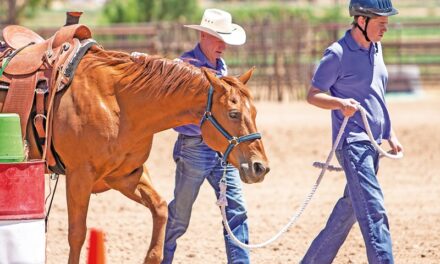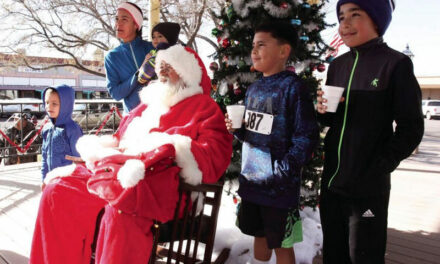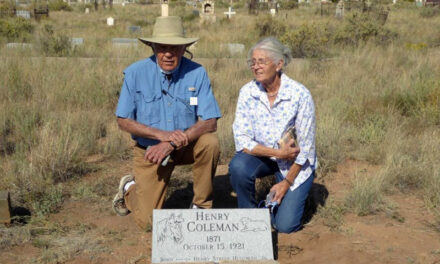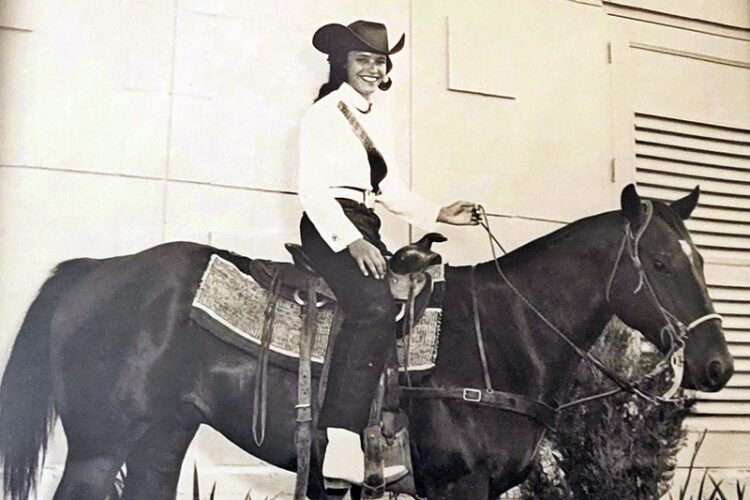
Paula was active in many different organizations; civil air patrol, girl scouts, and fairs. Pictured is Paula in 1963 at the Albuquerque Coliseum as the fair queen.
Courtesy photo
I have set out on a mission to record, collect, and preserve individual accounts of life in Socorro and the surrounding areas. My plan is to document the life experiences of people in our community, so future generations can enjoy tales from the past and ultimately learn from them. Memories are a profound way to capture the essence of a historical era long passed. Historical events, unique life experiences, and irreplaceable memoirs are just a few of the gifts received from an oral history interview.
It was my honor to interview a prior Socorro Librarian, rancher, fair queen, and friend, Paula Mertz.
Paula Mertz was born February 2, 1945, at Randolph Field Army Air Corps Base in San Antonio, Texas. Her father was in the service and her mom worked in the administration building. When they met and decided to get together, “It was quite the office romance.”
When World War II ended, her father decided to get out of the service and use his GI bill to become a veterinarian because he loved animals. However, the GI bills were not established yet, so his dream of becoming a veterinarian was diminished. Instead, he became what they called a “herdsmen,” thanks to his aunt Elizabeth McNerney, who got him the job. Paula was about 2 or 3 years old when her father worked on Houston Ranch, an export farm in Boerne, Texas. The farm sold registered livestock to many folks in South America, Cuba mostly. Elizabeth was her father’s favorite aunt, and when she married Bill, the entire family moved to Bingham, N.M.
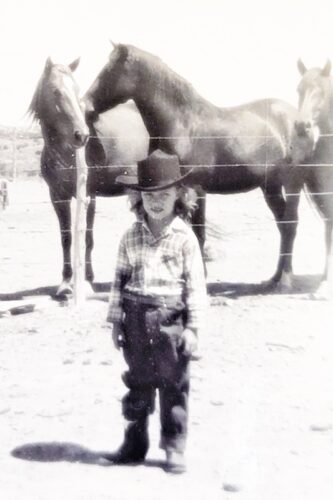
Paula’s father worked on her uncle’s ranch. She attended school at a one-room schoolhouse with other ranch kids.
Courtesy photo
Paula’s dad always wanted to be a cowboy, so when his uncle offered him a job on his ranch, he took it. They did not have electricity, but they did have a wind charger and they were way ahead of the wind-power people. This was 1950-51, and their lights were kerosene lanterns. Paula remembers learning to read, pointing out an old lantern in her front room.
“Truly, call me Abe Lincoln. I learned how to read by that lantern. The light wasn’t great, but I learned to read.”
In addition to learning by kerosene, she also went to a one-room schoolhouse with nine other kids. They were all ranch kids. Her first and best friend Bill Ryan was the only other first grader at the time. Ranches were so big and far apart that the only real socialization they got was in school. When the state decided to shut down small town schools to consolidate them into larger ones, Paula’s family moved to Socorro.
In 1953, her family had the choice to relocate to Carrizozo or Socorro. Her family chose Socorro because the area had more job opportunities for her dad and schools for the children. Paula went to Mount Carmel Catholic School, where the nuns terrified the previously sheltered ranch children.
Growing up in Socorro wasn’t hard for her, because it wasn’t a large community. The town’s population in 1953 was around 4,500. Paula recalls, “Everybody knew everybody else’s business for the most part, and if you didn’t, just stand still a minute and you would figure it out or hear it.”
Paula has one brother Chuck, who is 12 years younger than her. He is the kindest, gentlest person you’d ever want to meet, but Paula cautions, “He could be a little devil too. When I was a girl in high school, you have certain pieces of jewelry you like to wear, he would go in early in the morning while I was getting ready, in the restroom or something and hide it.”
Paula and Chuck had fun growing up in Socorro and to this day have a close relationship. They grew up in a Socorro long past that had the Hilton Pharmacy, Fair Store, Coronado Café, Safeway and Armory (where the Loma Theater is now). It was not long out of the war, and the kids would play on the tanks behind the armory. She remembers the jets coming out of White Sands. Playing a little havoc, the jets would hit the sound barrier and blow out the windows of many buildings. For Paula growing up, Socorro was the picturesque small town where you could ride horses and go to the fair.
She stuck with small communities and went to college in Enid, Oklahoma. Paula was married on August 19, 1967, to Neil Mertz. They met while in college at Phillips University; a small college in northern Oklahoma.
Paula explains what drew her to him, “Neil was one of the few young men on campus that dressed up every day. I mean, tie, sports coat, white shirt, and always ironed. I think when we got married, he had something like 23 white cotton shirts, and they were cotton not polyester.”
They didn’t have children until 1970, because Neil was going to school and Paula was working as a librarian in Waco, Texas. In 1969, Neil joined the service to prevent being drafted. Their first child, Brian, was born in a naval hospital in San Diego. They moved back to Socorro in 1977 after Neil finished his graduate degree at Baylor. He worked as an Assistant District Attorney to Claire Wagner. Their daughter Andrea Mertz was born in Socorro in 1979.
Raising children and working in Socorro was just as wonderful to Paula as growing up here. She explains what it was like in the 70s and 80s.
“It was where kids could go down the street at night and sit out under the streetlights and giggle and gossip, it was relatively safe, nobody’s going to bother. Everybody knew everybody’s car in town.”
She went on to work at the Socorro Public Library. Neil had a private law practice and ultimately became a district judge. His legacy lives on at the courthouse in Estancia, which was established as the Neil Mertz Judicial Complex.
Socorro has been a warm and accepting place for Paula throughout her life. She believes Socorro is a great town, always has been and always will be—not just within the Socorro City limits, but also the surrounding areas. This accepting attitude, she believes, comes from our history of caring for others.
Her advice for people living in Socorro today is, “keep your head down and mind your own business, also don’t be too judgmental and you will be good.”
The Oral History Project is still underway, and if you have recommendations for potential participants please contact the library. A complete record of the interviews will be retained at the library for people to read and listen to.
I encourage everyone to look within their own networks and record the many stories that future generations will treasure. As Gail Lumet Buckley said, “Looking at the people who belong to us, we see the past, present and future.”
The Socorro Public Library is located at 401 Park St., Socorro. 575-835-1114.


